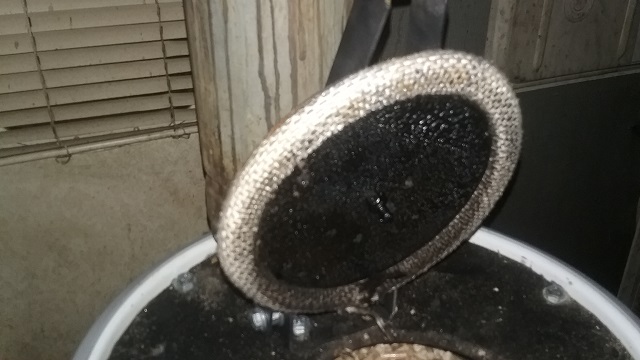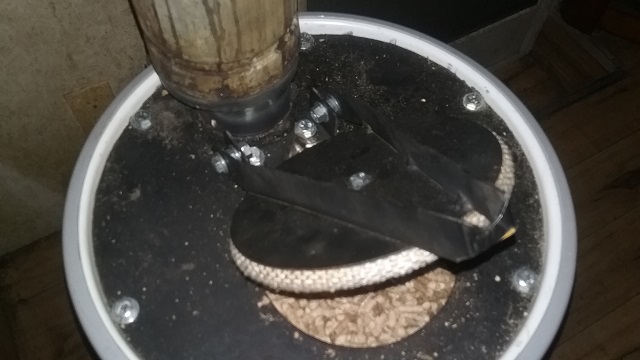A very intelligent youtuber named Mr. Teslonian, his wood gasifier designs for home heating and general use are great, and his chevy luv that he put a gasifier onto is what i am questioning. on his home heating gasifiers, he uses a method of using gravity to make an air tight seal. on his small truck, he wanted to make a long distance unit, so he put a much bigger wood hopper on the top. this stuck way higher above the truck, but is good for longer distances, i wanted to make a chamber that could be small, but also have the capability of expanding from a section of propane tank and two air tight seals.would this work? or would it not have an air tight seal because of two weak points?
You won’t find many fans of that. Particular fellow here. I suggest you ask him your questions directly.
Mr Teslonian may be intelligent but if he really wants to run his truck on wood gas, I would suggest he spends a bit of time here on DOW. Don’t get me wrong, I believe he has the basics down but Wayne’s design is so many levels above what Mr Teslonian has in his video. Yes, I spent the time and watched the whole thing, then I signed up with DOW. I had a ride in a truck this spring going 80mph on wood. For some reason I can’t remember who was driving. 
Basically, if you want to build a gasifier to run a vehicle, you are now in the right place. It really doesn’t get better than the guys here.
Hello Tylor Jaxon, welcome to the DOW.
Let me address this a different way for your goal of variable adjustable run times with larger/smaller hopper capacities.
Bare-in-mind this is based on my different systems operating experiences.
I lucked out that the very first wood gasifiers that I ran were GEK II’s. These had an internal small capacity “Experimenters” raw wood fuel zone. So you could first play around with different fuel types stocks. Then you would add on a ~25 gallon quarter can fuel hopper. Surprise. Surprised. With the only ~1 gallon internal fuel zone many different fuels stocks would work.
But . . . once you added on the extended run gravity feed tall hopper . . . only a few fuel types would give continuous use! Chunked, low ash, very dry No Bark woods. Or coarse screened chip/chunks of the same.
The problems? Fuel particles goo glueing themselves and NOT falling down to self feed! We call this bridging/tar capping.
Many, many have tries different mechanical interventions to make the fuel particles fall&flow. Hopper&system vibrators. Rotating arms and plunger rod “agitators” and “breakers”. Pre-charring (torrifing) the fuel particles. Produced gasses hopper heaters/fuel-warmers. Fuel particles augured-in feeds. Etc. Etc. Etc.
I fall into the category of those just accepting that a smaller fuel loading is actually easier in preventing these problems that trying to fix for them later. For me, ain’t so bad to have to every hour/2-hours refuel to get you back looking at the system for problems.
Wayne Kieth himself once a large hopper-man now uses smaller hoppers and says he looks forward to a 1-2 hour refueling stopping driving break to be able to get out and stretch his old bones. Walk off the sitting stiffing ups.
On your system sectional sealing go to a large hardware store and look in the woodstove section at the rolls of woven rope bulk fiberglass door and fire-viewing glass windows sealing material. Make your system to accept the largest diameter available (usually 1 inch round). Don’t need precision ground flanges to make this stuff airtight work. No even precise ground out tongue and groove joints. Ha! Look at the airtight woodstoves and it is just either rough castings or flat plate with some spot welded on rope-groove edge retainers.
Trick is you want that rope to be compressed ~50% with then edge/post mechanical stops to not over compress or system use vibrations squish out and damage-gap/leaks.
A to-be-safe engine sucked system will pull together and seal better when in engine operaton. Engine NOT running/sucking down is where you want to watch for gasifier leakages. And the problems of system leakages.
Regards
tree-farmer Steve unruh
Although all the manufacturers of small gas generators are moving towards a small silo with different systhème of feeding like the target of archimedes and a shaker to supplement the stock of the gasogene from a big stock of secondary fuel, but the agitator arm is a solution for regularity in volume and quality of syngas product, model attached, it exists more simple, and the mixture of essences of different density, to avoid the vault. so conlusion, with the pecking everything is possible
Tyler,
Welcome! Are you thinking of a flange-type joint or like an inner and outer tube sliding joint? I have been thinking of an inside tube sliding inside an outside tube (tank?) with a couple of large self-made red silicone “O-Rings” in there somewhere to fill the gap. I guess with a flange-type joint, you could add a section when needed. As long as it seals well!
Personally I think Mr. T is a hack. I have to see him build a system and show it working months later. I did ask some basic questions once a pon a time and was totally ignored. Everyone else that was ooohing and awwwing got answered… makes me wonder how much he really knows. Just my 2 cents.
Mr. T. Is paid MONIES from you tube to make projects. and his projests are miss leading on his claims. Hum makes you wonder who he is really sponsored by.
But one good thing is when I was checking his stuff out, it lead me to DOW. Where the results are a lot more positive, though everyone that’s always ready to help you out.
Bob
Hi Arvid,
Long time no hear from you. How’s life treating you? Well, I hope. I agree with your Mr. T comment. Too much left out
and some cut short and not a lot of “how to”. I’m satisfied with the results of my experimental unit, learned a lot, now I’m spending time on house stuff I put aside. I’m thinking of building a smaller unit this winter. Smaller unit gasifier, that is. Take care.
Pepe
I’m kicking around some ideas on a new system… just gotta go buy the parts and find the time to put something together.
I’ll keep everyone posted as it comes together.
Ha! Ha! Under the philosophy of putting your money where your mouth is:
I just bought 64 lineal feet of the woven fiberglass stove sealing rope that I’d recommended.
Sadly our north county hardware store was going out of business after 60 years. Killed off by Amazon and south county chain-stores the owner said in the newspaper.
So I cleaned off his one shelf for his retirement for him. Four different diameters. Meeco Mfg., Inc Seattle WA USA
www.meecomfg.com
Mine is the bronze 2000F sealer rope. Their white and black ropes are only rated to 1000F usages.
Again gasifer system sealing with this rope if done best is actually doing just as all modern no-leak anymore engine/transmission sealing is done.
The components to be sealed are mechanically hard surface to hard surface match up tightened down. The actual “sealer” component is 50% LIMITED compressed into channels in between these. No RTV or tacky “glue” is used on new installations anymore… Engine components resealing is most of the time possible. Heat stuck, then torn, on disassembly. THEN you use the goo-glue versus buying a new cover, or composite “gasket”. The composite “gaskets” are soft metals rimmed for compression limiting with a molded-on oil/fluids/coolant resistant inner elastomer thicker bead.
So using this rope-seal on a gasifier . . . make the grooved channel side on the upperside or cooler side component. Lower/opposing side can just be a flat surface. The inner rim/retainer of the can-be-an-open-sided square shaped channel does not have to be gastight! Can be skip spot welded. Channel Mus- be narrow enough to ~10-20% squeeze the rope. Assembly clamping to the opposite component then squeezing down the 50% rope standing up for final compression sealing.
And as it took me years to convince one particular hard-headed gasifer developer, IT WILL BE AIR/GASTIGHT for the low system pressures involved.
Gasifier metals temperatures vary in-use widely from one zone area to another. There WILL be materials heating expansion to deal with. Shut down gone cool - then contraction.
Making a hard welded flange exposed from the oxidization or intense charcoal glow zones across gas flow chambers to the system ambient temp outside is an seals failures experiences. Yeah. Yeah. Thicken the flange. Add more bolts. Upgrade the flange sealer to higher and higher high-tech!
Jeez-dude. Just move the joint up away from the most intense heat areas. Quit hard bolting rigid together, constrained. Successful rigid-jointing and you are then transferred stress’s than will flats warp/buckle and welds crack. Let things differential expanded and contract “float” on the rope seal.
Many/most modern vehicle engines cast iron exhaust, to downstream tube-steel exhaust pipe use actual spring loaded in-line heat-proof shouldered bolts to clamp with to allow for these systems movements.
Available at any North American auto parts stores. Salvage/Wrecking yards. Hint. Hint.
Regards
tree-farmer Steve unruh
Very insightful, I appreciate the experience won observations.
No doubt, you can’t overcome wild differential thermal expansion, you should just recognize it, compensate for it, and work with it. Great suggestion on the compressed gasket joints.
I now use a flanged rope seal on all lids/doors where heat is a concern. The flange part of the rope seal is sandwich clamped between the top lid and a lower smaller cut out plate. I use contact cement to put in place to hold for assembly. This has been the best and simplest arrangement I have found. Where heat is not a concern I use a press on bulb seal in those areas. New machines hopper heat is no longer an issue so those will get the better sealing bulb seal on next generations. Because heat is now eliminated at the hopper I am looking into a flex material to seal the lower hopper joint connection. This is to allow it to flex a bit while making the hopper vibrator more effective. I use very very little goo anymore, only place I can think of now is the face of the blower motor when mounting it to the housing.
On flanges I use high temp ceramic stick on seal gasket: been using this for 5 years now and have never had a problem.


Good confirmations MattR. (nope; the hardheaded I referred to was NOT Matt.)
VesaM in his books shows making up dedicated lids and joint seals with purpose layed and formed in-place, and then cured red high-temp RTV from a caulking gun tube.
For those still skeptical of the air-tightness of this loose weave fiberglass rope - just red high temp RTV impregnate it. Let that cure. Then glue it on. Actually the best of both approaches. Much more durable and reusable than just the plain solid non-reinforced RTV.
Hee! Hee! Yup. A bit messy to make up!
That is what kids, stand-arounds, and gawkers are for. Then fuel wood chunking; or, chips screening will seen very much easier and cleaner when put to work doing!
Wood-for-power requires a lot of DOing’s. Best introduce that early on.
Regards
tree-farmer Steve unruh
Where heat will allow, I use a tire inner tube for my hopper lid. Self spring loaded.